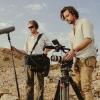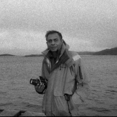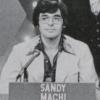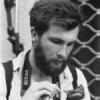Search the Community
Showing results for tags 'KODAK'.
-
Hey gang, I've got a roll of expired Kodak 500T EXR 7296 in my fridge here that I'd love to shoot. Trouble is it's a) pretty freaking old and b) probably hasn't been kept in a cool, dry place for a large part of its life. This particular film was discontinued in 1995 but could have been made anytime between then and 1989. Naturally there are too many variables to really know how it'll look but is there anything I should keep in mind if I want to shoot it? Rate it faster? Slower? Any thoughts would be great. Cheers, James.
-
(BYDGOSZCZ, Poland) - Kodak is hosting back-to-back conversations with renowned cinematographers Sean Bobbitt, BSC and Bruno Delbonnel, ASC, AFC at the 21st edition of Camerimage, the international film festival of cinematography, on November 21 at 7:00 (CMT) in the Opera Nova, first floor seminar room. Both Bobbitt and Delbonnel have films competing in the main competition: Steve McQueen's 12 Years a Slave and the Coen brothers' Inside Lewelyn Davis, respectively. Each discussion will be followed by an audience Q&A. Bobbitt, a BAFTA and Emmy® nominee, recently shot Killing the Messenger, The Place Beyond the Pines, 12 Years a Slave, Shame and Hunger. The latter three of those movies were done with McQueen. Delbonnel collaborated with director Jean-Pierre Jeunet on Amelie and A Very Long Engagement, and earned Oscar® nominations for both films. His credits include Dark Shadows, Harry Potter and the Half-Blood Prince, The Cat's Meow, Infamous and Across the Universe, which garnered the Silver Frog at Camerimage in 2007. "Camerimage is a wonderful opportunity for the cinematography community to share ideas and philosophies, as well as celebrate the art itself," says Andrew Evenski, president of Kodak's Entertainment Imaging business. "We are proud to be part of the 20-plus year history of this unique festival." This year's festival opens November 16 with a screening of Saving Mr. Banks which was photographed by John Schwartzman, ASC on Kodak film. For updates on what is happening at the festival, follow Kodak on Facebook and Twitter. For more information about the festival, visit http://www.camerimage.pl, and for more information about Kodak's motion picture films, visit www.kodak.com/go/motion. (Note: All participants are subject to availability) # # # About Kodak's Entertainment Imaging Business Kodak's Entertainment Imaging business is the world leader in providing motion picture film and imaging products, services, and technology for the professional motion picture and exhibition industries. For more information, visit www.kodak.com/go/motion. Media Contacts: ignite strategic communications Sally Christgau: direct 415.238.2254 / sally@ignite.bz Lisa Muldowney: direct 760.212.4130 / lisa@ignite.bz
-
- productioncinematography
- Camerimage
-
(and 4 more)
Tagged with:
-
Oscar®-Winner Guillermo Navarro Named 2013 Kodak Cinematographer-in-Residence at UCLA/TFT LOS ANGELES (November 4, 2013) — Kodak and UCLA’s School of Theater, Film and Television (TFT) have announced Oscar®-winner Guillermo Navarro, ASC, AMC will be the 2013 Kodak Cinematographer-in-Residence for the fall quarter at UCLA TFT. The mentorship program will kick off with a free screening of Guillermo Del Toro’s Pan’s Labyrinth on November 4, at the James Bridges Theater in Melnitz Hall. Navarro won the Best Cinematography Oscar® for Pan’s Labyrinth in 2007, and the film received numerous other accolades and critical praise. The screening is free and open to students, staff, faculty as well as the general public. A Q&A discussion with Navarro will be moderated by Professor Bill McDonald following the screening. In his 40-year career, Navarro has worked with such established filmmakers as Bill Condon (The Twilight Saga: Breaking Dawn – Part 1 and Part 2), Guillermo Del Toro (The Devil’s Backbone, Hellboy, Hellboy II: The Golden Army, Pacific Rim), Robert Rodriguez (From Dusk Till Dawn, Spy Kids), and Quentin Tarantino (Jackie Brown). Navarro is currently filming director Matthew Cullen’s London Fields. “We’re so pleased to be part of this incredibly successful program,” says Worldwide Marketing Director Johanna Gravelle, Entertainment Imaging, Kodak. “We are committed to this industry and supporting emerging talent.” The Cinematographer-in-Residence program was inaugurated by Professor McDonald in 2000 with the support of Kodak to enhance the learning experience of students with insight from renowned cinematographers. UCLA TFT is the only film school that offers a cinematography residency program such as this, where students can receive direct guidance from cinematographers through screenings, workshops and one-on-one sessions over the course of 10 weeks. Past mentors who have participated in the program include Dante Spinotti, ASC, AIC; Allen Daviau, ASC; Conrad L. Hall, ASC; Owen Roizman, ASC; Dean Cundey, ASC; Roger Deakins, ASC, BSC; Laszlo Kovacs, ASC; Joan Churchill, ASC; Stephen Burum, ASC; Victor J. Kemper, ASC; Vilmos Zsigmond, ASC, John Bailey, ASC and Richard Crudo, ASC. For additional information about the November 4 screening, visit http://www.tft.ucla.edu/event/pans-labyrinth-screening/ or call 310-206-8365. Admission is free, and on a first come, first served basis. Parking is available in Lot 3. There is an $12 parking fee. A limited number of pay-by-the-hour parking spaces are also available in Lot 3. # About Kodak's Educational Initiatives: Kodak's ongoing support of student filmmakers and educators encourages excellence in the field of motion picture education. The company's efforts include a range of programs that enrich knowledge and learning experiences in the art and craft of filmmaking. Initiatives range from scholarships, educational materials, and product grants to awards, seminars and workshops. Student film showcases and the annual KODAK Student Scholarship and Student Cinematography Awards also contribute to raising the profile and recognition of emerging talent. For more information, visit www.kodak.com/go/education or join Kodak on Facebook at http://www.facebook.com/KodakMotionPictureFilm and on Twitter at @Kodak_ShootFilm.
-
Hello, I'm doing some school project, and I need to know exactly how the processed and developed film negative (preferably Kodak Vision3) looks. Can someone, please, post here some detailed photos of processed and developed film negative that comes directly from camera (no copy)? I would be extremelly grateful!! :wub: What is the main differences between processed and developed negative from camera and distribution copy film stock? Does the distribution copies usually using the same film stock type that is used in camera? Is there some distribution copies on Kodak Vision3? Does Kodak Vision3 contain sound, and if yes, what type? Can Kodak Vision3 (or other camera film negative) contain SDDS or Dolby Digital sound, or just analogue optical audio? Many thanks in advance for all your replies!!
-
Hello I am about to shoot my year end final dialogue exercise in a month's time from now, the film has to be shot in studio space on 35mm film and sound synced. The film explores the internal conflicts of a family living in an lower middle class weared out house. It's raining or overcast in most part of the film and hence it is softly lit throughout but at the same time, I am trying to go for a higher contrast(not exactly very high) with lighting. Now, I am looking to create contrast within the space with respect to exterior and interior by the means of lighting (avoiding a lot of fill), a soft key coming from window bounced off a white board might work. As far as film stock is concerned I am thinking of testing two stocks, Kodak 5219 Vision 3 500T and Fuji Eterna 8583 400T, both to be pulled by a stop in combination with a low strength ultracontrast filter. This makes the colour desaturated and also makes the overall contrast low and blacks softer, but at the same time the contrast with respect to lighting would be higher (conventionally Key - Fill ratio will be higher). Sugesstions would be appreciated. Shashank Walia Cinematography,2011 FTII.
- 1 reply
-
- soft light
- high contrast
-
(and 6 more)
Tagged with:
-
Winners Represent Universities from Mexico, Africa, Germany and U.S. (LOS ANGELES, CA) Kodak and the University Film and Video Foundation (UFVF) have named the 2013 recipients of the KODAK Student Scholarship Awards and KODAK Student Cinematography Scholarship Awards, which were selected by a panel of judges led by award-winning cinematographer John Bailey, ASC. This year's winners represent film schools in Mexico, Africa, Germany and the United States. Kodak's annual global competition is designed to recognize emerging talent that demonstrates superior filmmaking skills and creativity. Accredited film schools from around the world nominated up to two students for consideration in each award category. They were judged on a combination of past work, faculty recommendations, and academic achievement. Judging took place in July. The KODAK Student Scholarship winners are: Gold Award - Carlos Eduardo Correa Reynoso from Centro de Capacitación Cinematográfica in Mexico, for his film Mr. Sabas. His award includes a $5,000 Kodak motion picture film product grant, and a $4,000 tuition scholarship. Silver Award - Werner Nortje from the AFDA in Africa for Jericho. The award includes a Kodak $4,000 motion picture film grant, and a $3,000 tuition scholarship. Bronze Award - Nicolas Navia from the American Film Institute (AFI) in the U.S. for his piece The Superman. The award comes with a $3,000 Kodak motion picture product grant and $2,000 tuition scholarship. The KODAK Student Cinematography winners are: First Place - Max Preiss from Deutsche Film Und Fernsehakademie Berlin (DFFB) in Germany for his cinematography on Come and Play. He receives a $5,000 Kodak film product grant and $3,000 to be applied toward his tuition. Honorable Mention - Daniella Nowitz, also from AFI, for her work on Sassafras. The award is a $3,000 Kodak product grant, and $1,500 for tuition. Kodak partners with the University Film and Video Foundation to make this program possible. The UFVF is a not-for-profit organization that engages in and promotes worldwide education, research, innovation, and charitable activities in the arts and sciences of moving images and aural communication. In addition to Bailey, the entries were judged by Melinda Levin, a professor at the University of North Texas and president of the UFVF, and Kodak's Lorette Bayle, who is also an award-winning filmmaker. Kodak introduced its worldwide film school program in 1991. Through the years, the program has grown to include a wide range of initiatives to help both students and educators enrich the development of their skills in the art and craft of filmmaking. For more information, visit www.kodak.com/go/education. About Kodak's Entertainment Imaging Business Kodak's Entertainment Imaging business is the world leader in providing motion picture film and imaging products, services, and technology for the professional motion picture and exhibition industries. For more information, visit www.kodak.com/go/motion. Follow us on Facebook (facebook.com/KodakMotionPictureFilm), Twitter (@Kodak_ShootFilm), and YouTube (youtube.com/KodakShootFilm). # # # Media Contacts: ignite strategic communications 818.303.8088 Lisa Muldowney - direct: 760.212.4130 / lisa@ignite.bz Sally Christgau - direct: 415.238.2254 / sally@ignite.bz
-
- scholarship
- awards
-
(and 3 more)
Tagged with:
-
Dear font of knowledge - also know as users of the cinematography forum, I am sure you have been asked this question many many times over, however I am afraid I am throwing myself upon your mercy again! I am from a small company based in London, and I have a bit of a problem.... I have 4 rolls of Kodachrome 40 film, newly shoot, sitting on my desk but with no place to go! once I received these rolls and looked into developing them I was very quickly told that no commercial companies anywhere in the world develop these films as the chemicals used are no longer being made.. The developing house I was speaking to however said that there may be entrepreneurs and super 8 enthusiasts that may have this golden grail of chemicals and be developing their own Kodachrome 40. And who may ever so helpfully be willing to develop mine? :) – I am not sure if this is true or even possible, but if it is, please get in touch. I have also been told/informed that Kodachrome can be developed in black and white. Has anyone done this, know of the results to expect etc etc. I am absolutely desperate to get these films developed – and I’m hoping that someone reading this will help with my plight! Many thanks for taking the time to read this. Best Claire
-
Can someone please enlighten us as to what percentage of the movie - World War Z was shot on film? The processing lab i saw on end credits was Company3.
-
Newcomers tend to ask if a certain film stock will over or underexpose in a specific camera they have just purchased when shooting in the automatic exposure mode. Has anyone actually gotten negative footage that was either too over-exposed or too under-exposed when shooting in the automatic mode, and of course assuming there was adequate light with which to shoot?
- 4 replies
-
- Kodak
- Vision super-8mm film stock
-
(and 2 more)
Tagged with:
-
Hi everyone, greetings! just shot an experimental short, a motivational short film on Running on S16mm. you can have a look at the link below. thanks n regards Prashantt cinematographer Mumbai
-
Hello - I'm in the process of finishing up a documentary that I shot last year. I'm almost at picture lock and it's time for me to start thinking about color correcting and grading my project. My film was shot on two different film stocks, Kodak's 50D 7203 and 500T 7219. Both films were processed normal and were given a flat pass telecine on a Baselight system to HD ProRes422HQ files. I've tried some correction tests with this footage and I am having a devil of a time getting everything to balance out. The transfer is obviously lacking in contrast, and when I try to correct that it knocks the color and saturation all out of whack. According to the scopes I am using (inside color and FCP) I have to drop the blacks way down and stretch the whites and the midtones way up in order for the spread to register correctly. In fact, it seems to take too much correction to add contrast to my footage. Is this the case? Am I doing to do much? I'm turning to you guys for some help and advice. Right now I'm not worried about grading the footage - just correcting it so it doesn't look flat. Below are some screen grabs from my project which should give you a good idea of what I'm dealing with. If you have any suggestions or comments please feel free to share them with me. I'm also happy to provide more screen grabs or answer any questions if you think it will help. Here's some shots from the 50D footage, all take in full sun around f16. http://www.flickr.com/photos/25291579@N00/9007383279/ http://www.flickr.com/photos/25291579@N00/9007384281/ Here's some shots for the 500T footage. Two were shot under fluorescent light at around f2, the last was shot using a practical tungsten fixture at around f4. http://www.flickr.com/photos/25291579@N00/9007385761/ http://www.flickr.com/photos/25291579@N00/9008568480/ http://www.flickr.com/photos/25291579@N00/9007388485/ I should mention that these screen grabs appear much darker than my actual footage. The blacks are not as strong in the 7219 footage as shown here, but they are very strong in the 7203 footage and these stills make them look even darker. I should also mention that this project will most likely be corrected using Apple's Color. Thanks in advance for your help, Aaron Martin
-
- color correction
- flat pass
-
(and 6 more)
Tagged with:
-
Kodak Goes Behind-the-Scenes With Acclaimed Cinematographers at Cine Gear Expo; Eric Alan Edwards, Giles Nuttgens and Rachel Morrison Headline Panels LOS ANGELES, May 29, 2013 — Kodak will host two discussions with acclaimed cinematographers at this year’s Cine Gear Expo on the Paramount Lot in Los Angeles. On Friday, May 31, at 5:15 p.m., Kodak will sit down with award-winning cinematographer Giles Nuttgens, BSC for a conversation in the Paramount Theater. On Saturday, June 1, at 11:45 a.m., the “Sundance in Summer” panel will feature Eric Alan Edwards (Lovelace) and Rachel Morrison (Fruitvale Station) in The Sherry Lansing Theater. In a candid conversation, Nuttgens will reveal the thinking behind his extensive body of work -- including the imagery, technology, career choices, and his collaborations. The seminar will offer a glimpse into the mind of one of today's more innovative artists. Nuttgens shot the recently released What Maisie Knew with the directing team Scott McGehee and David Siegel, and Midnight’s Children, based on the best-selling Salman Rushdie novel. Nuttgens’ extensive feature resume also includes Mehta’s elemental trilogy Fire, Earth and Water, which received a 2007 Oscar® nomination for Best Foreign Language Film and earned Nuttgens the 2006 GENIE Award for Best Cinematography. Nuttgens first worked with McGehee and Siegel on The Deep End, a film which earned him the 2001 Sundance Film Festival Award for Best Cinematography, and a nomination in the same category at the 2002 Independent Spirit Awards. His next films include the upcoming features Young Ones and God Help the Girl. Both Edwards and Morrison recently had movies that were stand outs at the Sundance Film Festival. This panel conversation will delve into their creative and budgetary considerations made prior to and during production. The cinematographers will also give the audience behind-the-scenes insight on the collaborations with their directors – Ryan Coogler who took his first turn at the helm on Fruitvale Station; and the dual visionary team on Lovelace comprised of Oscar®-winning director Rob Epstein and Emmy®-nominated Jeffrey Friedman, both with documentary backgrounds. Edwards’ film Lovelace is the story of adult film legend Linda Lovelace, who starred in the 1972 film Deep Throat. The film will hit cinema screens in August. Edwards received an Indie Spirit Award nomination for My Own Private Idaho, and has an eclectic list of credits including Gus Van Sant’s Even Cowgirls Get the Blues, Judd Apatow’s Knocked Up, David Dobkin’s The Change-Up, and the upcoming Delivery Man from director Ken Scott. Morrison lensed Fruitvale Station, which was the winner of both the Audience Award and Grand Jury Prize at the 2013 Sundance Film Festival. Based on real events, the film follows Oscar Grant on the final day of 2008, and his untimely death New Year’s Day at the hands of a transit police officer in Oakland, Calif. The film will be released by The Weinstein Co. on July 26. Morrison’s credits include Palo Alto, CA; and the upcoming thriller The Harvest, among others. Morrison will receive the Kodak Vision Award at the 2013 Women in Film Crystal + Lucy Awards® on June 12. The panel is free with admission to Cine Gear Expo. Advanced registration for the Expo can be done at www.cinegearexpo.com. The website also includes directions and additional information. To learn more about Kodak, visit www.kodak.com/go/motion, or follow Kodak on Facebook at http://www.facebook.com/KodakMotionPictureFilm and Twitter (@Kodak_ShootFilm). (Participants subject to availability.) # About Kodak’s Entertainment Imaging Business Kodak’s Entertainment Imaging business is the world leader in providing motion picture film and imaging products, services, and technology for the professional motion picture and exhibition industries. For more information, visit www.kodak.com/go/motion. Follow us on Facebook (facebook.com/KodakMotionPictureFilm), Twitter (@Kodak_ShootFilm), and YouTube (youtube.com/KodakShootFilm).
-
Kodak Appoints Christian Richter to Film Lab and Studio Relationship Manager ROCHESTER, NY (May 14, 2013) – As part of Kodak’s ongoing efforts to support the motion picture film infrastructure, the company has appointed Christian Richter to the newly created role of film lab and studio relationship manager, effective immediately. Richter will be responsible for developing and managing strategies to optimize the workflow between studios, filmmakers, laboratories and post-production facilities. He will report to Andrew Evenski, Kodak’s president and general manager of the company’s Entertainment Imaging division. “There is a growing concern that the changes occurring in the industry will be detrimental to the motion picture film infrastructure, and we want to alleviate that concern,” says Evenski. “There is a thriving, global lab network and many filmmakers are choosing film. Christian has more than 15 years of extensive, international experience to contribute to this new role. He will liaise with our customers and promote the options for shooting anywhere in the world, utilizing the high-quality film system in place to support those productions.” Since joining Kodak in 1997, Richter has worked solely in the Entertainment Imaging division, fulfilling roles on an international scale. His responsibilities have ranged from managing the business unit’s initiatives for students, film schools and emerging filmmakers in Germany, to general management of Kodak’s Cinelabs in Dubai and Bulgaria. After developing broad international sales experience over several years, he became an integral part of Kodak’s product development and innovation advocacy teams, working with R&D scientists to drive product quality and growth. His business acumen includes a skill set for overseeing people, projects, products and industry partnerships. Richter is currently the business manager for Europe, the Middle East and Africa, a title he’ll maintain as he embarks on his new responsibilities. Previously, he was the Business Development Manager for Western Europe. “I want to make it as easy as possible for filmmakers to shoot on film, regardless of where they are shooting around the globe,” says Richter. “Filmmakers do not have to shy away from using film because of uncertainties around the availability of laboratory services. That infrastructure is in place. At the same time it will be exciting to work with the lab community, ensuring their services are well promoted within the industry.” # About Kodak’s Entertainment Imaging Business Kodak’s Entertainment Imaging business is the world leader in providing motion picture film and imaging products, services, and technology for the professional motion picture and exhibition industries. For more information, visit www.kodak.com/go/motion. Follow us on Facebook (facebook.com/KodakMotionPictureFilm), Twitter (@Kodak_ShootFilm), and YouTube (youtube.com/KodakShootFilm).
- 1 reply
-
- Kodak
- motion picture film
-
(and 3 more)
Tagged with:
-
Hey guys, anyone know the difference between the 200T and the 250D? I understand the 250D is for daylight. But for the 200T, its shot alot in daylight, so whats the advantage - AND its tungsten balanced....so it would make sense to shoot at night...with slow speed??? Doesnt make sense. Anyway, hopefully you guys will be able to explain. And please dumb down the technical lingo a tad lol Im not a cinematographer - just someone who wants to learn. I do storyboards, and i might direct in the future and knowing this may come in handy. Thanks! Also, how far can I underexpose with the 200T?? And the 250D? I know with 500T you can go under to EI 1600. But what about these faster stocks?
-
I'm a film student currently in pre-production for my first 16mm film. We have three rolls of film stock, and can choose from 50T, 250D, 250T and 500D We have three different aesthetics: One indoor scene in a swimming pool, where we will hopefully have 3/4 natural light and I'm hoping we will be able to use 250D Kodak stock, using only natural light. Two outdoor scenes (although in the English countryside, in May) in one of which we are hoping to acheieve a look similar to 70s photographs of Californian swimming pools, such as http://www.latimes.com/features/home/la-hm-backyard-oasis-photos,0,7657842.photogallery?index=la-hm-backyard-oasis-photos-002 while in the other, we are hoping to acheieve a colder 90s style such as this film demonstrates: http://vimeopro.com/yvonlambert/sallatykka/video/40155357 Sorry for the very long post, but does anybody maybe have some advice on which film stock to use? We are using the Arri SR3 and have access to 'basic filters' Thanks!
-
To all those film stock experts! I have just started learning about film stock at film school BUT we are shooting our first short films soon and need some extra help! I am planning to shoot my film outside at an oval - Potentially simulating sunset for most of the shoot and I was wondering what the best film stock to use would be! I really want to make the most of sunset and dusk, creating beautiful silhouettes etc. My teacher is saying go with 500T, but it could be grainy when shooting later. What do others think? Thanks in advance, Josie
-
ROCHESTER, NY (February 28, 2013) - John Bailey, ASC, a renowned cinematographer known for his artistic contributions to cinema, will spearhead a panel of judges for the 2013 Kodak student scholarship program. This international competition acknowledges student filmmakers who demonstrate exemplary filmmaking skills and creativity at the undergraduate and graduate levels. The deadline for entries is May 17. Accredited film schools around the world may nominate up to two students for consideration for the KODAK Student Scholarship Award, and one cinematography student for the KODAK Student Cinematography Scholarship Award. The cinematography student nominee may also be nominated for the KODAK Student Scholarship Award. Nomination forms can be downloaded at www.kodak.com/go/scholarships. Bailey has a long list of memorable feature film credits including American Gigolo, Ordinary People, The Big Chill, Silverado, The Accidental Tourist, Groundhog Day, In the Line of Fire, As Good as it Gets, Incident at Loch Ness, Brief Interviews With Hideous Men, The Greatest, Country Strong, When in Rome and most recently Big Miracle. He also blogs for the American Society of Cinematographers - John's Bailiwick - on a range of topics that affect the art and craft of filmmaking. "John's experience and mentorship skills make a huge contribution to this scholarship process," says Kodak's Johanna Gravelle. "Students from around the world will receive feedback from him to assist in their efforts to succeed in filmmaking. We are extremely grateful to John for his ongoing commitment to this program and to sharing his knowledge with the next generation." Kodak, in collaboration with the University Film & Video Foundation (UFVF), holds this annual scholarship to encourage students pursuing a career in filmmaking. As part of the competition, the judges will review sample reels, as well as evaluate the students' faculty recommendations and academic achievements. The following prizes will be awarded to the finalists and announced in August: KODAK Student Scholarship Award: * Gold: $4,000 tuition scholarship and $5,000 Kodak motion picture film grant * Silver: $3,000 tuition scholarship and $4,000 Kodak motion picture film grant * Bronze: $2,000 tuition scholarship and $3,000 Kodak motion picture film grant KODAK Student Cinematography Scholarship Award: * First Place: $3,000 tuition scholarship and $5,000 Kodak motion picture film grant * Honorable Mention: $1,500 tuition scholarship and $3,000 Kodak motion picture film grant Since 1991, Kodak has been supporting future filmmakers and encouraging excellence in the field of motion picture education. The company's ongoing efforts include a range of opportunities that students and educators can use to enrich their knowledge of the art and craft of filmmaking, including educational materials and discounts, in addition to sponsorship of film festivals, awards, seminars and student showcases that raise awareness about emerging talent. For more information, visit www.kodak.com/go/education.
-
- Kodak
- Call for Entries
-
(and 3 more)
Tagged with:
-
Finally finished writing my article after several months of research and tests. I'm putting it out there, so if anybody in the future is interested they can learn everything they need from this article to get them going. Article Includes: - The film advantages and disadvantages. - Development times. - Procedures. - Workarounds. And much more information. Thanks https://republicphoto.squarespace.com/s/ECN-DEV4.pdf
-
The 2013 Academy Award® best picture nominees include six movies that were shot on Kodak film: Argo, Lincoln, Silver Linings Playbook, Django Unchained, Beasts of the Southern Wild, and Les Miserable. In the 84-year history of Oscar®, no Academy Award®-winning best picture has ever been made without motion picture film. "We congratulate all of the 2013 nominees for their remarkable achievements,” says Andrew Evenski, president and general manager of Kodak’s Entertainment and Commercial Films Group. “We are honored that so many talented filmmakers continue to choose Kodak technology to tell their stories and create extraordinary images.” Movies made on Kodak film received a total of 56 nominations. In the four acting categories, an overwhelming majority (16 of 20) of the nominated performances were captured on motion picture film. Additionally, three of the five nominees for best cinematography relied on Kodak film to create their compelling imagery, as did three of the five directors acknowledged in their category. Evenski also notes that Kodak is still making billions of feet of film. “Many of those reels will be loaded into cameras that are capturing movies that will contend for Academy Awards in 2014.” Kodak’s Entertainment Imaging Division is the world-class leader in providing film, digital and hybrid motion imaging products, services, and technology for the professional motion picture and exhibition industries. For more information, visit www.kodak.com/go/motion.
-
hello everyone, I'm a final year cinematography student of ftit, chennai, tamilnadu. Within a month, I'm going to do my diploma film, the academic exercise.My director wants a blue tone overall the movie. so somebody give me suggestions to achieve it since i'm a budding cinematographer. Herewith I'm attaching all the equipments i would be provided : Arriflex III, 500T (2 nos), 200T (4 nos), lenses- 24mm-290mm zoom, 24mm, 35mm, 50mm, 85mm, light- 1kw, 2kw, 5kw. I know many methods would be available like using filters and all, but i would like to know the effective method that would be apt for the mentioned requirements. By the way, the diploma genre is a thriller. Regards Kirubanidhi
-
Looks like Kodak wants us to get excited. Here's a video of the assembly line for 50D.
-
Hi Cinematography.com people... I've just released a director-cinematographer 1st promo, shot with no budget other than stock, developing and telecine and would love some feedback if you had a few minutes. The idea was to create a mood and tone rather than a certain narrative. https://vimeo.com/54611682 H.Grimace "Lands of Gold and Green" With kind thanks, Ash (Ashley Michael Briggs).
-
There doesn't seem to be much experience-based info floating around about 5230 500T... I'm just curious if anyone here has shot this this stock and can comment on it's look, grain, and the result that push/pull has on contrast, color, and grain. Anyone done full or partial skip bleach with it? Any other notables? I'm beginning to evaluate stocks for a project, and I'm wondering if I can get significantly different looks by mixing '30 with 5219 and playing with processing, since I'd need an ASA 500 stock for the entire project. Also, 5230 doesn't seem to bear the Vision label... is this a DI-minded stock or something else? Cheers,
-
Can someone tell me how vision3 and vision2 differ? Also what would you consider the nicest daylight stock? I can't find any decent hd examples of vision3 50d, could someone please link a few?









